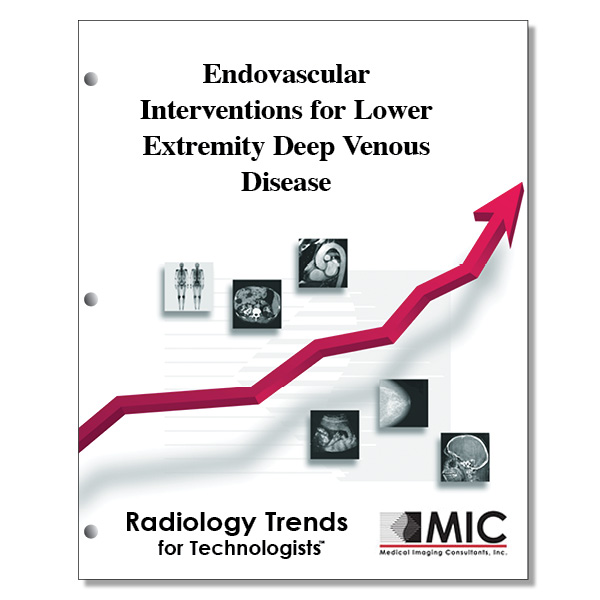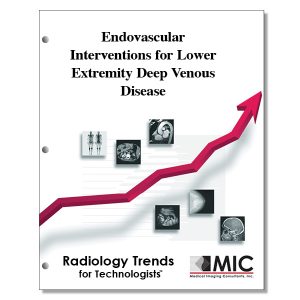

Endovascular Interventions for Lower Extremity Deep Venous Disease
A comprehensive review of the state of the art in the endovascular management of lower extremity deep venous disease.
Course ID: Q00466 Category: Radiology Trends for Technologists Modalities: CT, Vascular Interventional3.25 |
Satisfaction Guarantee |
$34.00
- Targeted CE
- Outline
- Objectives
Targeted CE per ARRT’s Discipline, Category, and Subcategory classification for enrollments starting after January 28, 2025:
Cardiac-Interventional Radiography: 3.25
Patient Care: 0.50
Patient Interactions and Management: 0.50
Procedures: 2.75
Interventional Procedures: 2.75
Registered Radiologist Assistant: 3.25
Patient Care: 0.50
Pharmacology: 0.50
Procedures: 2.75
Neurological, Vascular, and Lymphatic Sections: 2.75
Vascular-Interventional Radiography: 3.25
Patient Care: 0.50
Patient Interactions and Management: 0.50
Procedures: 2.75
Vascular Interventional Procedures: 2.75
Outline
- Introduction
- Part 1: Acute Lower Extremity Deep Vein Thrombosis
- Epidemiology
- Beyond Pulmonary Embolism: Postthrombotic Syndrome
- Risk Factors for Developing PTS after DVT
- Noninterventional Methods to Prevent PTS
- Beyond Anticoagulation: The ìOpen Veinî Hypothesis and Lessons Learned from Systemic Thrombolysis for DVT
- Image-Guided Endovascular Thrombus Removal: Description and Evolution of Techniques
- Patient Selection for Catheter-directed Therapy: Anatomic and Clinical Considerations
- The Role of Imaging in Stratifying Patients and Planning for Potential Intervention
- Outcomes of Interventional DVT Therapy
- Part 2: Interventional Management of Chronic Lower Extremity Deep Venous Disease
- Background
- Patient Assessment
- Noninterventional Management
- Imaging Assessment
- Patient Selection and Preparation
- Interventional Treatment of Iliocaval Stenoses and Occlusions
- Complications
- Postprocedural Management
- Outcomes
- Conclusion
Objectives
Upon completion of this course, students will:
- state the prevalence of lower extremity deep venous disease
- discuss the most feared consequence of deep venous thrombosis
- list three parenteral anticoagulation drugs
- list the symptoms of post-thrombotic syndrome
- recall outcomes from the Venous Thrombosis Outcomes (VETO) study
- explain pathogenesis of post-thrombotic syndrome
- recall complications from reflux and or obstruction of the venous system
- list patient types that have relatively minor risk of post-thrombotic syndrome
- explain what types of DVT increase risk of post-thrombotic syndrome
- identify medical trials associated with treating post-thrombotic syndrome
- state how VTE is associated with post-thrombotic syndrome
- recall the first endovascular thrombolytic method for DVT
- list alternate access points for when the popliteal vein is occluded
- list the lytic drugs currently used in clinical practice for CDT procedures
- state the typical infusion time period for catheter-directed thrombolysis
- identify the imaging modality utilized before, during, and after lytic therapy
- list treatments for post-thrombectomy obstructive lesions
- list the potential disadvantages of percutaneous mechanical thrombectomy
- name the components of pharmacomechanical catheter-directed thrombolysis
- list the general categories for PCDT technique
- discuss the groups of clinical severity for DVT
- describe patients suitable for aggressive therapy to prevent PTS
- review imaging modalities to determine highest sensitivity and specificity for detection of infrainguinal deep venous thrombosis
- state the imaging modalities used for evaluating difficult patients with DVT
- review limitations of multiple interventional DVT studies
- recall what catheter-directed thrombolysis trial was sponsored by the National Heart, Lung, and Blood Institute
- know the annual cost associated with venous ulcers in the United States
- state how chronic venous disease develops
- review statistics related to chronic lower extremity disease and PTS
- explain the importance of documentation criteria for chronic lower extremity deep venous disease
- list non-interventional options for DVT treatment
- name the indications for imaging the deep venous system in chronic venous disease
- indicate the use of computed tomography for imaging IVC filters
- state the routes of entry into the venous system
- document patient positioning for accessing the popliteal vein
- list the types of iliocaval obstructions
- describe findings from the PREPIC trial
- identify the best imaging modality for detection of luminal narrowing
- state the most common complication associated with interventional treatment of venous disease
- state the duration of anticoagulation therapy for non-thrombotic disease
